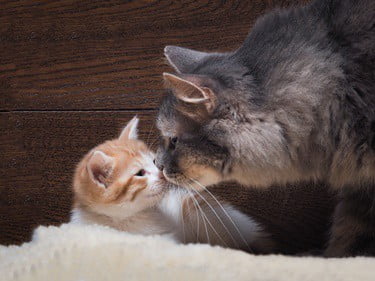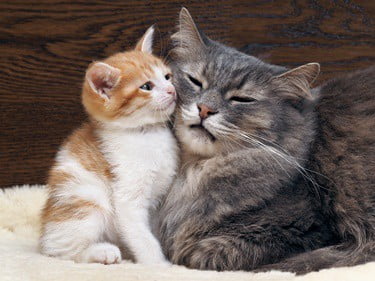Adopting a kitten when you have a senior cat isn’t a decision that should be taken lightly. Older cats like to live a quiet life on their own terms, while kittens are energetic, playful, and high maintenance.
In readiness for the introduction, share the kitten’s scent with your senior cat before it enters the home. Introduce the cats by sight, but keep them apart physically. Create positive, unified experiences and assure your older cat that it hasn’t been forgotten. Given time, some older cats will learn to accept a new kitten.
Bringing a kitten home to a senior cat doesn’t need to start a feline civil war. Just be careful how much you expose the animals to each other, at least initially. If you get the early encounters right, you stand a better chance of integration.
Can a Senior Cat Get Along with a Kitten?
Most house cats can live long, contented lives. This means that cats spend more time as seniors than in any other stage of their life. Cats are considered seniors from the age of 10, and geriatric cats beyond the age of 15.
As cats age, they start to wind down. The Journal of Feline Medicine and Surgery explains that many senior cats struggle with osteoarthritis or degenerative joint disease. This will leave them reluctant to play, hunt, or even move.
Getting a kitten when you have a senior cat can reinvigorate your incumbent cat. Kittens have an infectious energy that some older cats enjoy. You may find that your older cat rediscovers a sense of playfulness and starts to interact with its surroundings more.
Unfortunately, the opposite effect is more common. Many senior cats find kittens excessively boisterous, energetic, and annoying. Couple this with the territorial nature of cats and you have a recipe for a challenging dynamic. “I just got a new kitten and my older cat hates it” is a common lament among owners.
It’s possible to help your older cat to accept the arrival of a new kitten. This is unlikely to happen overnight, though. You’ll need to manage the introduction of the two cats carefully. First impressions can set a lifelong precedent.
Introducing a Kitten to a Senior Cat
You only have one chance to make a first impression, and cats remember unpleasant experiences. Get the introduction wrong, and your older cat may hold a lifelong grudge against the kitten.
Never spring the arrival of a kitten on your existing cat. Felines guard their home from infiltrators. If not expecting a new housemate, the kitten will be treated the same way as an intruder. Your cat will assume the kitten plans to steal resources or territory.
Prepare your cat for the arrival of the kitten through scent. Before your kitten comes home, start applying its scent to the home. Leave a favored toy on the floor and bring home a blanket that smells like the kitten.
This may still result in your senior cat acting strangely. It will likely start looking high and low for this new cat in the home, and it may become clingier as it fears being replaced. However, these measures will make the eventual arrival of the kitten less surprising.
Once you bring your kitten home, you’re ready to make the necessary introductions. Follow this process to give yourself the greatest chance of success.
Introduce by Sight
Now that your senior cat is familiar with the kitten’s scent, it needs to learn how to recognize it by sight. This should be done from a safe distance and behind a protective barrier. Bring the kitten home in a carrier and leave it inside.
Allow your senior cat to approach and let the cats see each other. They need to understand that they share the same home. Keep these visual introductions behind barriers for a while. The older cat is likely to start hissing and must be kept away from the kitten.
If you want to let the kitten free, let the cats observe each other from opposite ends of a corridor. Do not let them get close to each other as neither cat is ready for this yet.
Restrict the Kitten
Kittens are naturally curious and energetic and want to explore the home immediately, but this isn’t an option yet. Not only does this place the kitten at risk of injury, but it’ll upset the resident cat. The kitten should be restricted to a single room for at least a week.
Your senior cat will have claimed large swathes of your home as territory. It will take time before it is willing to accept another feline in this terrain. So, you’ll need to keep the kitten out of its path while it adapts.
If you have a spare bedroom, this is the perfect place for the kitten. Fill this room with a bed, toys, food, water, a litter box – everything a kitten could need. You should visit the kitten in this room regularly, playing and petting to strengthen your bond.
Speak to your kitten, too. As per Animal Cognition, cats recognize their owners by voice rather than appearance. You may need to get your kitten’s attention while you allow it to interact with the senior cat. Start the training early.
Arrange a Dinner Date
The way to a cat’s heart is through its stomach. This makes dinner dates a great way to enhance the introduction of senior cats and kittens. Feed both cats at the same time, divided by a barrier.
The best way to do this is to feed the kitten in its assigned room, placing a cat in the doorway. Place the senior cat’s food bowl on the other side of the barrier. As this is a change in routine, you may need to encourage your cat to eat in this unfamiliar locale.
With luck, both cats will eat their meals. The presence of the other feline will not go unnoticed, though. Both cats will associate the other with food. This is a good thing as most cats will do anything for a favored snack, including accepting another animal.
This dinner date will reassure your senior cat that things aren’t changing drastically. The arrival of the new kitten doesn’t mean that you’ll stop feeding your older cat. Over time, trust will start to grow.

Schedule a Playdate
The time has come to bring the cats together. This should be done for a short time, under careful supervision. You’re not ready to give your kitten the freedom of the house just yet.
Place both cats in neutral terrain. Positioning a kitten in a senior cat’s territory will spark aggression. Equally, avoid inviting a senior cat into the kitten’s territory. If a fight breaks out, the kitten may no longer feel safe.
Put the two cats together and make a fuss of them equally. If the two cats ignore each other or interact calmly, praise and offer them a treat. This reinforces desirable behavior and makes them see each other as a source of pleasure.
Initially, only keep the cats together for a minute or two. Over time, you can start to increase this time. After a while, introduce games into the playdate to encourage physical interaction.
Leave the Cats to Interact
Eventually, you’re going to need to allow the cats to interact freely. This doesn’t involve leaving the cats unattended and unsupervised. It just involves seeing how well the cats tolerate each other when not guided.
Place the cats in the same room while going about an everyday task, such as the laundry. This means the cats won’t be expecting you to govern their interaction. Check for any signs of conflict.
There may still be a little hissing at this stage. As long as this is as far as it goes, that’s fine. If claws are unsheathed, disrupt this right away. A loud noise, such as clapping your hands, will usually do the trick.
If a fight does break out, the cats aren’t ready to co-exist yet. It could be months before you reach this stage, so patience is essential. Return to restricting the kitten and attempt steps 3 and 4 again in a few days.
How to Get Older Cats to Accept Kittens
While kittens are great fun for their owners, they can be a nuisance or threat to older cats. There are many reasons why senior felines struggle to accept kittens. In addition to the unrelenting energy of a kitten, these include:
- Dislike of change and disruption to routine
- Fear of being replaced or forgotten
- Loathing of ceding territory or sharing resources
- Instinct to guard the home from infiltrators or intruders
- Lack of socialization for the kitten
The latter can be a stumbling block for the relationship between a kitten and a senior cat. Kittens learn appropriate behavior from their mothers and littermates. If separated too soon, the kitten will lack critical social skills.
Most kittens are ready to be rehomed at 8 weeks. The kitten is no longer reliant on its mother at this age. The next month remains critical for socialization, though. If possible, adopt kittens once they reach 12 weeks.
Even then, you’ll still need to work to ensure that your older cat and kitten live in harmony. There are various steps:
Assign Separate Territory and Resources
If cats had a dictionary, the word “share” would not be listed in it. Cats retain the wild instincts of their ancestors. This means that they guard their possessions and claim anything that they can for themselves.
If you want an older cat to accept a kitten, don’t ask it to share resources. Your kitten needs its own food and water bowls, bed, litter box, and toys. Your kitten may be willing to use the same resources as a senior cat, but this acceptance is unlikely to be reciprocated.
Ideally, keep these resources apart from each other. Food bowls should start in opposite corners of a room. This will prevent the cats from coming into conflict when aggression is most likely, such as mealtimes.
Both cats will need their own territory. Older cats need a quiet place to call their own and watch the world go by. Ensure your senior cat has this territory, and it isn’t accessible to the kitten.
The same applies to your kitten. If you don’t assign an area for your kitten, it will start scratching stair carpets or furniture to claim the whole house. If both cats have their own terrain, they’re more likely to ignore each other.
Maintain Routine
Getting a new kitten is a whirlwind of excitement. You’ll need to prepare the home for your new pet and monitor it carefully. Kittens are curious and mischievous and could get into all manner of trouble otherwise.
This is important, but you mustn’t forget your incumbent cat. Felines loathe changes to routine. Depression after a new kitten arrives in the home is common. You need to retain a routine so that your senior cat doesn’t feel forgotten.
Do everything you ordinarily would with your senior cat. Keep mealtimes to the usual scheduled time, and if your cat still enjoys play, treat this as normal. If you are petting your new kitten, pet your senior cat, too. Cats do get jealous.
This can be a balancing act. Kittens require a lot of attention and energy, but you must ensure that the needs of the existing cat are met. If the old cat feels like the kitten is taking its attention or resources, it may behave aggressively.

Permit a Hierarchy
All cat pairings have a dominant and submissive social hierarchy. Often, this is assigned by age. Alas, some kittens can be bold and try to assert dominance over a senior feline. In such instances, the kitten will need to be put in its place.
This will see your older cat hissing or swatting at the kitten. Note that this is not the same thing as an older cat attacking a new kitten. The gestures should be born of ballast and act as a warning. If a genuine fight breaks out, the cats must be separated.
Animal Behavior suggests that male cats are less dominant than females, especially where food is concerned. The journal posits that male cats don’t need to be in prime physical condition for breeding. A male kitten may be more likely to accept a submissive role without complaint.
The body language of a submissive cat is to lie flat on the tummy or back, making itself look as small and unthreatening as possible. Submission doesn’t mean a cat is unhappy, as long as it is not being bullied.
How Long Does it Take for an Older Cat to Accept a Kitten?
Cats are living creatures with their own thoughts, feelings, and desires. Some senior cats will accept a kitten almost immediately, while others may take months to come to terms with a new arrival.
No two cats should be expected to get along in less than a month. It may take 3-4 months before you can leave them alone. It depends on how cantankerous the senior cat is and how quickly the kitten calms down.
The more positive experiences your senior cat has, and the more you assure it that it won’t be neglected, the faster it will accept the kitten’s presence. As discussed, a positive introduction is also vital.
If you’re expecting your incumbent cat to act as a parental figure, you may be disappointed. Some cat pairings are never outright friendly. In many cases, simple indifference and tolerance should be considered a victory.
Getting a kitten when you have an elderly cat will usually be challenging. These trials don’t need to be insurmountable. You’ll need patience and understanding and to prioritize the comfort of your incumbent cat, at least initially. A positive, well-paced introduction will go a long way to achieving this objective.


I found this post extremely helpful and I liked that it doesn’t sugar-coat the process or trivialise with ‘kitty’ language. I am in the process of introducing two bonded kittens (sisters) to a young girl cat (aged 3). The first week was very stressful because we thought she hated us. She ate, used her litter tray, but hissed at her own toys which I found upsetting because I’m the one she plays with. The kittens live in the kitchen and there have been a couple of planned intros in carriers but they were very hissy and some accidental ones which oddly, went better. Peaceful sniffing followed by a hiss. Both kittens backed down. Now my girl cat has settled and I can play with her again. I still think we’re a way off complete harmony and we’re two months in. We’re taking it very slowly.
Very helpful information. We have just introduced an 8 week old kitten to our 2 older cats. One adult cat is 6 yrs. old and the other one is 9 yrs. old. The 9 yr old is having behavior issues with the kitten. The 6 yr old cat plays and sets boundaries for the kitten.
After 2 weeks in our home, the new kitten has had her own secquestered room, litter box, water and feeding dishes and toys. She now runs around the house and plays with the 6 yr old.
The 9 yr old still hisses and does not want this invasions of ‘her’ territory. We will now start their feedings all together, keeping the kitten in another area in the same room. We have learned now to play with them at the same time, show equal amounts of affection as well.
We have switched the kitten’s sleeping blanket now with the 9 yr old feline’s sleeping blanket. Hoping the 9 yr. old will start learning the kitten’s scent.
Will put the kitten in the same living room in her own cat carrier so maybe the 9 yr old cat will get used to the kitten easier, on her own terms.
Thaks for your video. It has given us good ideas to help introduce the kitten to the 9 yr. old cat.